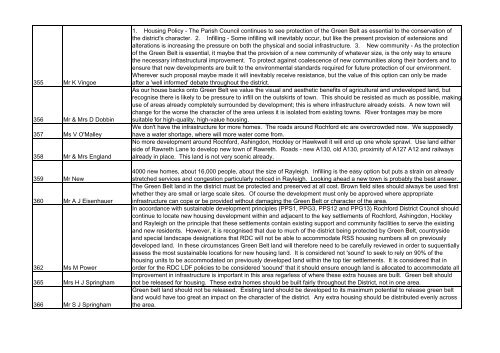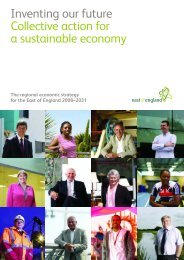Planning - Summary of all comments - Amazon Web Services
Planning - Summary of all comments - Amazon Web Services
Planning - Summary of all comments - Amazon Web Services
You also want an ePaper? Increase the reach of your titles
YUMPU automatically turns print PDFs into web optimized ePapers that Google loves.
355 Mr K Vingoe<br />
356 Mr & Mrs D Dobbin<br />
357 Ms V O'M<strong>all</strong>ey<br />
358 Mr & Mrs England<br />
359 Mr New<br />
360 Mr A J Eisenhauer<br />
362 Ms M Power<br />
365 Mrs H J Springham<br />
366 Mr S J Springham<br />
1. Housing Policy - The Parish Council continues to see protection <strong>of</strong> the Green Belt as essential to the conservation <strong>of</strong><br />
the district's character. 2. Infilling - Some infilling will inevitably occur, but like the present provision <strong>of</strong> extensions and<br />
alterations is increasing the pressure on both the physical and social infrastructure. 3. New community - As the protection<br />
<strong>of</strong> the Green Belt is essential, it maybe that the provision <strong>of</strong> a new community <strong>of</strong> whatever size, is the only way to ensure<br />
the necessary infrastructural improvement. To protect against coalescence <strong>of</strong> new communities along their borders and to<br />
ensure that new developments are built to the environmental standards required for future protection <strong>of</strong> our environment.<br />
Wherever such proposal maybe made it will inevitably receive resistance, but the value <strong>of</strong> this option can only be made<br />
after a 'well informed' debate throughout the district.<br />
As our house backs onto Green Belt we value the visual and aesthetic benefits <strong>of</strong> agricultural and undeveloped land, but<br />
recognise there is likely to be pressure to infill on the outskirts <strong>of</strong> town. This should be resisted as much as possible, making<br />
use <strong>of</strong> areas already completely surrounded by development; this is where infrastructure already exists. A new town will<br />
change for the worse the character <strong>of</strong> the area unless it is isolated from existing towns. River frontages may be more<br />
suitable for high-quality, high-value housing.<br />
We don't have the infrastructure for more homes. The roads around Rochford etc are overcrowded now. We supposedly<br />
have a water shortage, where will more water come from.<br />
No more development around Rochford, Ashingdon, Hockley or Hawkwell it will end up one whole sprawl. Use land either<br />
side <strong>of</strong> Rawreth Lane to develop new town <strong>of</strong> Rawreth. Roads - new A130, old A130, proximity <strong>of</strong> A127 A12 and railways<br />
already in place. This land is not very scenic already.<br />
4000 new homes, about 16,000 people, about the size <strong>of</strong> Rayleigh. Infilling is the easy option but puts a strain on already<br />
stretched services and congestion particularly noticed in Rayleigh. Looking ahead a new town is probably the best answer.<br />
The Green Belt land in the district must be protected and preserved at <strong>all</strong> cost. Brown field sites should always be used first<br />
whether they are sm<strong>all</strong> or large scale sites. Of course the development must only be approved where appropriate<br />
infrastructure can cope or be provided without damaging the Green Belt or character <strong>of</strong> the area.<br />
In accordance with sustainable development principles (PPS1, PPG3, PPS12 and PPG13) Rochford District Council should<br />
continue to locate new housing development within and adjacent to the key settlements <strong>of</strong> Rochford, Ashingdon, Hockley<br />
and Rayleigh on the principle that these settlements contain existing support and community facilities to serve the existing<br />
and new residents. However, it is recognised that due to much <strong>of</strong> the district being protected by Green Belt, countryside<br />
and special landscape designations that RDC will not be able to accommodate RSS housing numbers <strong>all</strong> on previously<br />
developed land. In these circumstances Green Belt land will therefore need to be carefully reviewed in order to suquenti<strong>all</strong>y<br />
assess the most sustainable locations for new housing land. It is considered not 'sound' to seek to rely on 90% <strong>of</strong> the<br />
housing units to be accommodated on previously developed land within the top tier settlements. It is considered that in<br />
order for the RDC LDF policies to be considered 'soound' that it should ensure enough land is <strong>all</strong>ocated to accommodate <strong>all</strong><br />
Improvement in infrastructure is important in this area regarless <strong>of</strong> where these extra houses are built. Green belt should<br />
not be released for housing. These extra homes should be built fairly throughout the District, not in one area.<br />
Green belt land should not be released. Existing land should be developed to its maximum potential to release green belt<br />
land would have too great an impact on the character <strong>of</strong> the district. Any extra housing should be distributed evenly across<br />
the area.
















